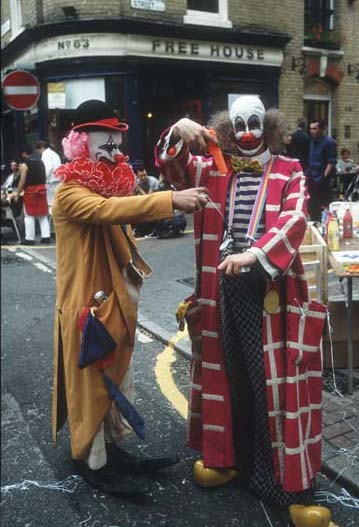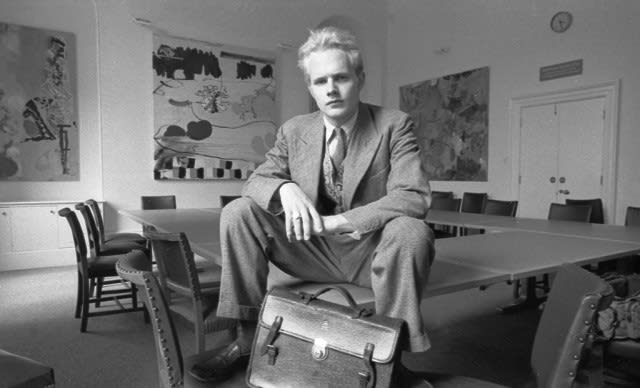This age needs a brave and fun “Hero of modern art” such as Apollinaire. I will try to fulfill such a role. —Joshua Compston
LONDON — Genius, unskilled manager, talented art dealer, troublemaker: the figure of Joshua Compston is one of inconsistencies and contradictions, even 18 years after his death.
The son of a judge, educated at St Edward’s School, Oxford, and at the prestigious Courtauld Institute of Art, Compston settled in Hoxton, in London’s East End, after completing his studies. It was the early 1990s, some time before the neighborhood became the trendy hotspot of today, still derelict and dangerous. Few people would even venture into the nearby district of Shoreditch, now a fashionable hipster paradise, then comprised of abandoned warehouses and squats. Compston was captivated by that environment, so different from his comfortable middle-class upbringing and from the hedonism that had taken root in West London. And so he opened a gallery there, Factual Nonsense, in 1992.
From the outset, Factual Nonsense was unconventional, and Compston’s most remarkable feat was to intercept what was then going on in the art world, the zeitgeist, before probably anyone else. His innovative approach quickly became apparent. In the summer of 1993 he organized “A Fete Worse Than Death,” a sort of deranged version of a traditional village fete, staged near Hoxton Square.

The event has become the stuff of legend. Artists Damien Hirst and Angus Fairhurst dressed up as clowns, inviting visitors to pay 50p to create their own spin paintings to be signed by the pair (since most people only had a pound, for the extra 50p you could see their privates, which had been painted by Leigh Bowery). Tracey Emin ran a kissing booth (50p for a kiss); Gavin Turk hosted a bash-the-rat stall; Brendan Quick set up a pubic-hair exchange. While James Goff was grilling tuna fish tails, Sarah Lucas gave her thoughts “on any matter” for the modest price of 20p. A year later, a second fete featured performances by various artists’ bands: Gavin Turk’s Killers and Cannibals, Cerith Wyn Evans’s People should beg God to stop, and Leigh Bowery’s Minty.
“A Fete Worse Than Death” was, by most accounts, brilliant, chaotic, and an economic disaster. It bound together an interesting mix of characters and brought 4,000 visitors to an area most people barely knew existed. But it also sealed the fate of Shoreditch. Gary Humedescribes what happened in the district in the book Factual Nonsense: The Art and Death of Joshua Compston, a collection of memories compiled by artist Darren Coffield:
Within a year and half everything had gone up in price. People could no longer be there. A coffee house arrived and another one. The Fete was the beginning and the end of it.
To celebrate Compston’s memory and the 20th anniversary exhibition of the fete, Coffield organized another one on July 19 in the same location, much in the same spirit of the original. A complementary exhibition hosted by Red Gallery features pictures and videos paying tribute to Compston’s life and work, and displays memorabilia from the original Factual Nonsense. Most of the objects, leaflets, and documents are for sale, to raise money for a Compston memorial to be erected in nearby Hoxton Square.
The 2014 fete featured 12 hours of live performances, running from noon to midnight, with the most singular stalls possible. Among the more noteworthy: a man reenacting famous death scenes (with a rather limited range including Cleopatra, Robert Maxwell, and Martin of Aragon), a woman making “Surreal Poem Portraits” (whatever that means) and freshly cooked ice cream prints for sale, a blackmail stall where you could compose your own blackmail letter using newspaper cutouts. The atmosphere was joyous and thrilling — the exact vibe one expects from such an event in such a part of town — and the crowd a mix of hipsters, cool parents with trendy kids, and the usual spectrum of alternative arty types. People got drunk and high in much the same way as 20 years ago.
As far as I could tell, there were neither famous artists nor strong artistic promises among the offerings this time. While the fete organized by Compston is now a part of art history, its 2014 version won’t achieve that level of recognition. But it wasn’t meant to: Coffield’s ambition with the anniversary fete was to celebrate the first one in the most eccentric way possible; trying to re-create the original wouldn’t have worked — too much has happened since then, too many people have moved to hip Hoxton. Celebrating the past is always better than exhuming it. And this doesn’t mean forgetting: the fete was festooned with posters and leaflets about Compston’s life, work, and death. As Coffield explains in his book:
The book and the exhibition came about because it seemed incredible that this unique and brilliant individual who was one of the main driving forces in the regeneration of Hoxton and Shoreditch should be totally forgotten whilst others claim credit for his ideas.
Joshua Compston died of an overdose of ether on March 5, 1996, aged 25, alone and broke. His difficult character had alienated even his closest friends. Nevertheless, there was a huge turnout for his funeral. Gilbert and George attended, accompanied by most of the London art world; the press was there, too, so the funeral has been extensively documented. The coffin, painted by Gary Hume, Gavin Turk, and Fiona Rae with a William Morris pattern, was carried through the streets of Shoreditch while a New Orleans jazz band played “When the Saints Go Marching In.”
Just one year later, Charles Saatchi’s Sensation opened at the Royal Academy. The artists Compston had promoted, the same ones who’d participated in “A Fete Worse than Death,” became the YBAs, the Young British Artists phenomenon. Gentrification began to turn Shoreditch and the East End into the fashionable enclaves they are today. The world Compston helped create changed and moved on without him.
“A Fete Worse Than Death 2014” took place on July 19, noon–midnight, at the corner of Charlotte Road and Rivington Street. The exhibition continues at Red Gallery (1–3 Rivington Street, Hoxton, London) through July 31. A special evening reception will take place on July 30 to mark the day of the 20th anniversary of the original fete.
